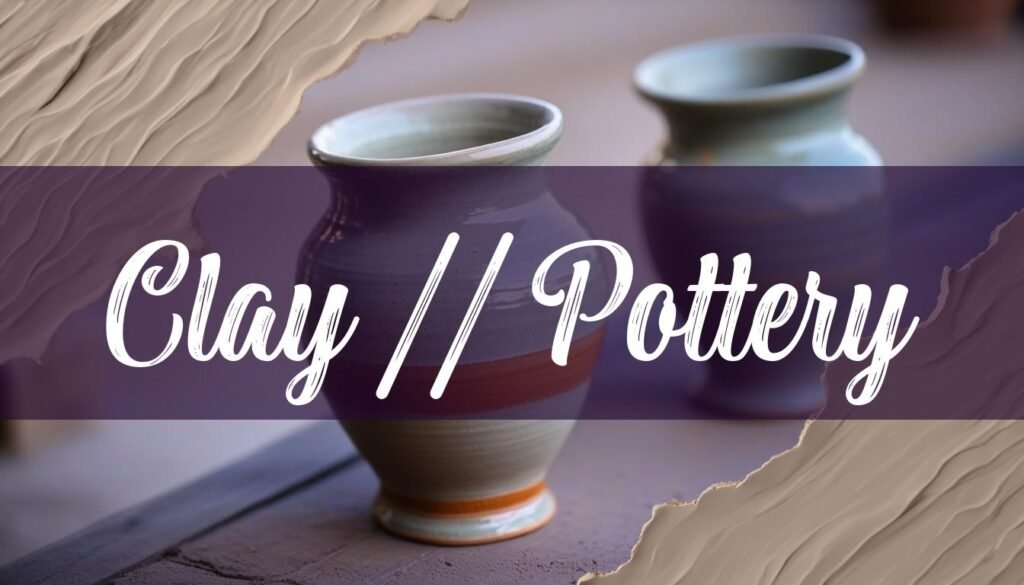To begin your journey into the captivating world of clay pottery, you’ll need a few essential materials and tools. The possibilities are endless, and starting with the basics will set a solid foundation for your future creations.
Clay
First and foremost, you will need clay. Clay is the heart and soul of pottery. There are several different types of clay to choose from, each with its own unique characteristics, firing temperatures, and suitability for various projects. The main types of clay that potters commonly use are earthenware, stoneware, porcelain, ball clay, fire clay, and air-dry clay. Earthenware clay is known for its rich, warm colors and lower firing temperatures, generally maturing between 950°C and 1,100°C (1,745°F and 2,012°F). Because it is porous, it’s often used for making plant pots, but it can also be used for bowls and plates once glazed. Its forgiving nature makes it a popular choice for beginner potters. Stoneware clay is a durable and versatile option that fires at higher temperatures, typically between 1000°C and 1380°C. It’s ideal for creating functional items like dinnerware and kitchenware, as it’s non-porous and can withstand daily use. Porcelain clay is often considered the most refined option, firing to a translucent finish at high temperatures. It is favored for delicate and intricate pieces like fine art sculptures and tableware. Ball clays are known for their plasticity and are often mixed with other clay types to improve workability. Fire clay is highly resistant to high temperatures and is used in products that require such resistance, such as bricks for kilns. Air-dry clay is unique in that it hardens naturally in the air without firing in a kiln or baking in an oven. For those interested in using local clay, here’s a guide to sourcing local clay.
Tools
Tools are also essential for shaping and decorating your clay creations. While a pottery wheel is a classic tool, many other hand-building tools can help you create unique forms. Some useful tools include: bladed tools, which are great for sculpting, molding, carving, adding intricate details, and smoothing your clay; potter’s needles, which are slender steel tools with needle-like heads used for sculpting, creating intricate details, parting projects on the wheel, and removing clay carefully; wire clay cutters, which are used for cutting wet clay and removing finished pieces from the wheel head or bat; fettling knives, which have a flexible blade that tapers to a point and is used for removing mold marks, sculpting clay models, trimming, and carving; ribs, which are used for smoothing and finishing clay on the wheel; scrapers, which are used to remove clay and create different patterns with their edges; ribbon and loop tools, which are used to cut and remove sections of clay, sculpt, trim, carve, create texture, and craft intricate details; sponges, which are used for adding texture or smoothing clay; brushes, which are used to draw images, create fine details, craft different patterns, apply slip, add delicate lines and bold strokes, apply wax resist, paint on underglazes and overglazes, and more; and pottery calipers, which are used to measure the inner and outer dimensions of your clay creations, precisely where they’ll join with other parts of a set.
Firing
The firing process is essential for transforming raw clay into durable ceramic pieces. Firing involves heating the clay and glazes to a high temperature in a kiln, allowing them to mature and reach their optimal level of melting. The firing process typically occurs in two stages: bisque firing and glaze firing. Bisque firing is the first firing, which transforms greenware (newly shaped clay pots) into a durable, semi-vitrified porous state. During bisque firing, the last of the atmospheric water is driven out of the clay. The bisque firing continues until the kiln reaches about 1730 degrees Fahrenheit. After bisque firing, the pottery is ready for glazing. Glaze firing is the second firing, where a layer of glaze is applied to the bisqueware and then fired in the kiln. The kiln is heated slowly to the proper temperature to bring the clay and glazes to maturity, then it is slowly cooled again. This second kiln firing completes the transformation of pots from a soft, fragile substance to one that is rock-hard and impervious to water and time. The type of kiln used and the firing schedule will also have an effect on the color and texture of the glaze. If you’re having issues with your kiln, here’s a guide to troubleshooting your electric kiln.
Glazes
Glazes and decorative slips add the final touches to your pottery, enhancing both its appearance and functionality. Glazes are impervious layers or coatings applied to bisqueware to color, decorate, or waterproof an item. Common glazing techniques include dipping, brushing, pouring, spraying, splattering, stippling, sponging, glaze trailing, and wax resist. Dipping is an easy way to cover pottery, giving the finished piece a smooth look and fine texture. Brushing can be used as both a base layer and for decorating, allowing for different brush stroke directions to create unique effects. Pouring involves flowing the glaze over the piece, creating an even layer on the interior and exterior. Spraying is best for laying down a precise base layer that is typically not achievable with other methods. Splattering is a fun and carefree way to apply glaze, giving your piece wonderful texture and an abstract look. Stippling is done when shadow effects are needed or if you want your glaze to have the look of being painted on. Sponging can add texture to your piece, allowing you to create various designs such as flowers and clouds. Glaze trailing is a technique where you draw glaze-on-glaze or glaze-on-clay designs, creating natural and abstract artwork. The wax resist technique repels glazes and underglazes, allowing you to create patterns by applying wax to specific areas. Types of glazes include gloss, matte, and crackle, each offering a different visual and tactile experience.
Safety
Finally, safety should always be a priority when working with clay and kilns. When handling clay, especially in large quantities, wearing a dust mask can prevent inhalation of fine particles. When operating a kiln, it’s essential to follow the manufacturer’s instructions and wear safety glasses and heat-resistant gloves to protect yourself from high temperatures. Proper ventilation is also crucial to avoid inhaling harmful fumes released during the firing process.
With the right materials, tools, and techniques, you’ll be well on your way to creating beautiful and functional clay pottery. Enjoy the process of experimenting, learning, and expressing your creativity through this timeless art form.





